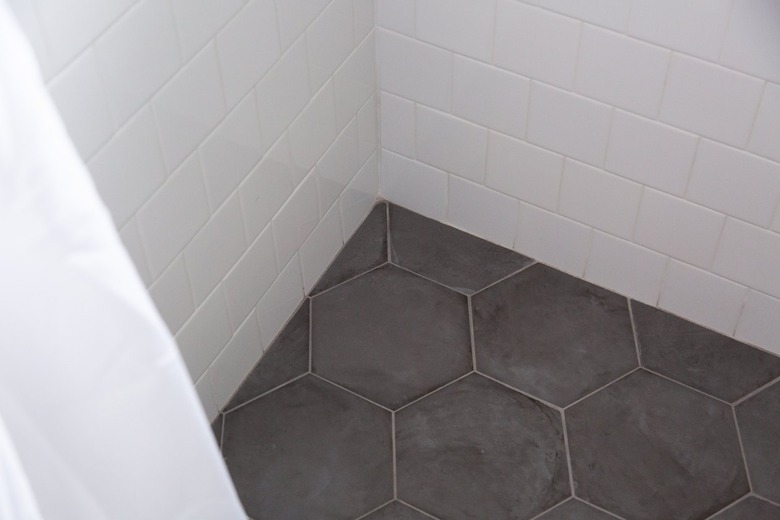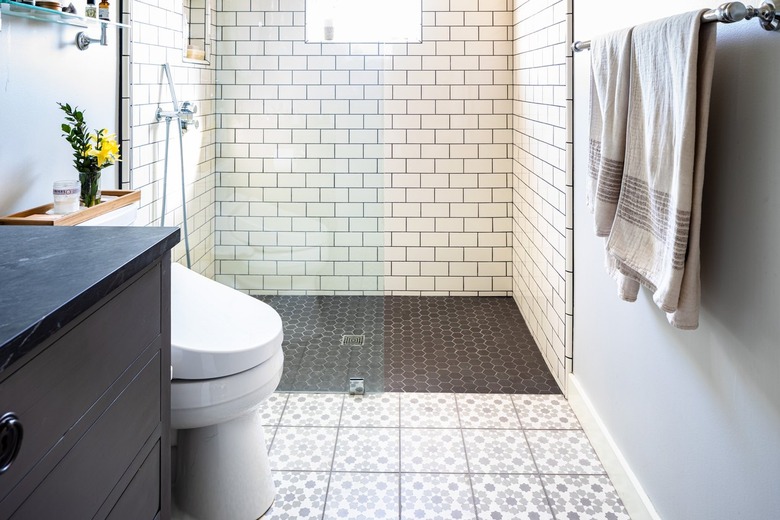Choosing Shower Bases And Pans: A DIY Guide
When you are ready to remodel your shower, you might visit showroom after showroom, leaving your mind teeming with ideas for stylish showerheads, faucets, shower doors and what kind of tiling or other finish materials will line the walls. While shower bases might not be the most exciting aspect of the redesign process, these are perhaps the most important part of the entire shower. That's because shower pans that lack sufficient waterproofing can leak, leaving you with mold and a damaged floor structure that may require the entire shower to be ripped out later down the line.
Shower Base Materials
Shower Base Materials
One of the most important things to look for in a shower base is its material. The four most common options are fiberglass, acrylic, solid surface and tile. Less commonly used are cast iron and copper. Each has its pros and cons, which include the following:
Fiberglass shower base: Made from molded fiberglass with a gel coat finish.
- Pros:
Lightweight, inexpensive, attractive finish. - Cons: The color
only runs as deep as the finish, which will eventually wear down and stain.
Scratches are very noticeable since they are a different color than the surface.
When the finish becomes stained, it is difficult to clean. There are fewer color and size
options than for other materials.
Acrylic shower base: Made from heat-fitting acrylic over a fiberglass base.
- Pros:
Lightweight, easy to clean, durable, available in a wide range of sizes and colors.
Because the color goes all the way through, scratches aren't as visible, and
light scratches can even be polished out. - Cons: Caustic
cleaners can cause permanent damage to the surface. It is more expensive than
fiberglass.
Solid surface shower base: Made from ground minerals and polymer resins, similar to solid surface countertop materials.
- Pros: Sturdier
than acrylic and fiberglass, resistant to many cleansers, luxurious appearance,
wide array of design options and can be made in custom or standard sizes and
shapes. - Cons: More
expensive than fiberglass and acrylic, though high-quality solid surface is
worth the extra investment. It can scratch and chip reasonably easily, although like
acrylic, the color goes all the way through, minimizing the visibility of
scratches. Light colors may turn yellow after some time. Not all bases come
with tile flanges, which makes leaks more likely.
Tile shower base: These can either be built from scratch or built with a precast base, typically made of polyurethane. When buying the tile, always look for materials with a slip-resistant texture.
- Pros: Durable. You
have more control over the finished product since you can choose the color, shape
and layout of the tiles. Materials can be relatively inexpensive depending on
your tile choice, though these savings may be negated by expenses related to
hiring a professional installer. - Cons: Tile grout
is more difficult to clean than most shower pan materials. Even with a precast
base, tile installation can be time consuming, exact and difficult, so many
homeowners will need to hire a professional. Grout needs to be resealed regularly to keep out moisture and so do many tile
materials.
Cast iron: Made from cast iron covered in enamel.
- Pros: Elegant
look, durable, will not crack, retains heat well, rarely leaks, matches well
with cast iron tubs. - Cons: Expensive, heavy, limited
color options, slippery (although a nonslip texture can be added to the metal
prior to enameling). Chips in enamel are difficult to repair.
Copper: Made from sheets of copper that are molded to a custom shape.
- Pros: Naturally
antimicrobial, attention-grabbing, retains heat well, often made from recycled
materials, can be made in any size or shape. - Cons: Expensive and
has to be custom made. MassRealty warns that copper shower pans are also prone to corrosion and frequently end up leaking.
Prefab vs. Custom Shower Pans
Prefab vs. Custom Shower Pans
When deciding on a shower base, you need to choose whether prefab shower pans or custom bases are better for your home. These terms can sometimes be a bit confusing because there are both stock and custom-made prefab shower pans, and these are different from custom shower bases. Similarly, while custom shower pans are made with tile, not all tile shower bases are custom. Essentially, a prefab shower pan is one that comes to you ready to be installed, whether they need to be custom made to fit in your bathroom or not. This includes tile-ready bases that are designed to have tiles installed on top of them but do not require you to custom install a liner and mortar base.
A custom shower base, on the other hand, must be completely designed and built from scratch, including the mortar base, shower liner and tile. A totally custom tile shower base is rarely a DIY project, and most people, even those with a decent level of home improvement experience, should hire a professional tile contractor for this process. That's because a shower base is difficult to tile just right, and even a small puncture in the shower liner can lead to leaks that can go undetected for years. Even more difficult than the tile is getting the slope or drain angle just right to prevent pooling water and poor drainage. This is why many municipalities require a permit for custom shower bases as well as inspection of the work after the liner has been installed.
To lay down a custom shower base, the drain must first be installed. It's worth mentioning that this is one nice thing about custom shower bases since there is no set drain location, so if you already have a drain, you don't need to worry about finding a center drain, right-hand drain or left-hand drain shower floor.
Once the drain is ready, the installer first builds a shower base with 2x4 boards and hardboard siding for any curves. He will then lay a thin layer of mortar and install the shower base liner, which will be covered with metal lath followed by another layer of mortar. Each layer of mortar must be sloped toward the drain to prevent standing water from pooling. Once this layer of mortar dries, the tile installation can begin.
Tile-Ready Shower Pans
Tile-Ready Shower Pans
While still considered a prefab base, tile-ready shower kits offer much of the same customization as a fully customized tile shower base and offer a relatively easy installation process compared to a fully custom pan. These are sold as a one-piece base with the drain already integrated inside and built-in tile flanges. This means all you have to do is lay the tile on top of the base without worrying about proper drainage and potential leaks. It's worth mentioning that properly laying tile can still be a challenge for many DIYers, so it's still often worth hiring a professional to install your tile. The only major downsides of these bases is that they can be expensive, and there is slightly less customization involved than if you do the entire project from scratch.
Barrier-Free Shower Pans
Barrier-Free Shower Pans
When shopping for shower bases, it's also important to consider whether you want a shower with a water barrier or one without. While shower pans have traditionally had a barrier to hold water in, many people like the look and easy access of barrier-free shower bases (also called curbless or walk-in bases). These do not have any rim and rely instead on proper drainage to keep water in the shower area. While these may be quite trendy right now, they are not for everyone, so it's important to consider the pros and cons, which include:
- Pros: Stylish, easier
to clean, can eliminate the need for shower doors, seamlessly blends in with
the rest of the shower floor, can be safely accessed with a wheelchair, no trip
risk (which can be a problem even among those without limited mobility). While
many curbless showers are custom designed, there are also plenty of prefab
options for walk-in shower bases. When combined with handrails and shower
seats, they can be part of an ADA-compliant shower design, which can increase home
value. - Cons: While it is
possible to add a door across the threshold of a curbless shower, most people
leave these showers open, which often results in shower spray leaving the
shower and heat loss since the steam is not trapped. This can also result in
a feeling of reduced privacy.
Shower Base Shapes
Shower Base Shapes
Shower bases can come in just about any shape and size and can even be custom ordered for uniquely shaped showers or particularly large showers. When it comes to stock designs manufactured by companies such as American Standard, Kohler or DreamLine, shapes include rounded designs as well as squares, rectangles and neo-angles.
While squares and rectangles are pretty straightforward, it's worth mentioning that you need a single-threshold shower base for showers constructed in an alcove or a double-threshold shower base for a corner shower. The threshold number refers to how many shower walls (including a door wall) will be installed. Also, be sure to keep in mind the drain location when buying because a corner or right-drain configuration will not work if your drain is on the left side.
While few people are familiar with the term "neo-angle," almost everyone has seen a neo-angle shower before. These bases are designed for corner showers and have a triple-threshold design, meaning the front of the shower is broken into three sides with the two front angles both set at 135 degrees.
While curved showers can come in a variety of shapes, there are two main varieties for stock shower pans: those with two straight sides and those with three. When the design has two straight sides, it is made to sit in a corner with the front wall curved to provide a stylish flair. Designs with three straight sides can fit against a wall, in a corner or in an alcove, and the curved wall allows the user to get a little more elbow room while showering.
References
- Innovate Building Solutions: Advantages and Disadvantages of a Curbless Walk in Shower
- Re-Bath: What Type of Shower Base Should You Use?
- wiseGEEK: What Are the Pros and Cons of a Cast Iron Shower Pan?
- MassRealty: Copper Shower Pans vs. Rubber Membranes
- Diamond Spas: How to Decide on the Best Bathroom Shower Pan for Your Space


